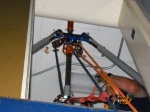As a guy who is called upon to perform rope rescues in a predominately urban environment, it has always struck me as interesting that, while there are plenty of rope skills that can be applied to any environment, the urban setting provides it own unique sets of challenges. To be clear, the urban setting is its own environment; it is not industrial and it is even further removed from the wilderness environment.
By constantly operating in and being on rope in the urban environment, we have run into many of the same challenges as you have. Because of this constant immersion, a solid grasp of the forces involved, and a willingness to try out just about any setup if there is a solid belay anchor, we have developed some excellent techniques for dealing with the problems that the urban setting throws our way.
With that in mind we have developed the Modern Technologies in Rope Rescue class. With a good foundation in the basics of rope rescue these classes will take some simple techniques that, with a few subtle yet critical changes, will allow you anchor and operate in the urban environment where you might have previuously thought it next to impossible.
-Kelly
Modern Technologies in Rope Rescue (16 hours)
Has your department kept up with advances modern rope rescue equipment? If you are still using the RPM( Rack, Pulley, Mariners) method of rigging and running your ropes over the edge of the cliff, building, etc… then this class is for you. Let R2T come show you the latest equipment and techniques to help streamline and simplify your rope operations.
This class will cover the basics of Two Tensioned Rope Systems using the CMC Multi-Purpose Device; why it simplifies the rigging for both your anchor team and your edge team and how it can minimize the shock to a belay system.
Also covered are several uses of the Rock Exotica AZTEK kit: from load release and knot passing to pick offs and rappelling for quick access.
While the mountain rescue guys get all the love in the rescue world, the fact remains that operations in an urban environment are every bit as challenging and constructing anchors can be quite a chore if you are not used to looking for them or have never seen some of the different anchors we show; in particular our Appalachian Doortex. This obvious spin-off of a name utilizes the Arizona Vortex for an anchor and high directional at the same time.
Day two of the class delves into using artificial high directional in different configurations for the urban rescuer as well as anchor construction that will allow afor a simultaneous high point and anchor for elevator shaft rescue. We’ll as using doorway and window spans for anchors
This is a class for the urban rigging geek!
Intro To Rope Rescue (2 day class)
Our two day Basic Rope Rescue class is designed to introduce new students or re-familiarize students that may need a refresher, to operating rope rescue systems.
This class teaches students safe, easy to remember techniques that will allow them to be able to function as part of a team during a rope rescue. During the class we cover many essential tasks:
- Introduction to equipment
- Incident size-up and needs
- Knotcraft
- Anchor selection
- Proper Belay Technique
- Constructing a haul system
- Constructing a lowering system
- Patient packaging
- Rappelling





Love the vortex photos…!!! How much force have you placed on the penta plate while resting on the pins? Curious on what you were rigging in the first photo here?
There are a couple of pictures on the bottom of the multimedia page that show a wider view of what we were accomplishing. Basically, we were doing a sideways easel A Frame. The leg with the V5 RigPlate was being held in tension against the concrete column. The V5 was just used as our lashing point. There doesn’t appear to be enough leverage from the V5 to do any damage; the pins are absolutel strong enough and the bottom of the V5 doesn’t do any damage to the legs. It was designed by Rock Exotica t be used with the AZV.
I’d tie the rope around my waist, have it over that ‘something’ and hold it with my hands. I can ealisy descend to the platform then just pull it (it’s not tied to the roof), and repeat again the same process.
I did not design that plate to be used in this manner. Rigging plates and not designed for flexing. The forces should be applied through the long axis. Those are not tested for cross loading like carabiners. That will weaken the plate and fail if there is enough.force. What that force is??? Who knows because it is not tested in that manner…